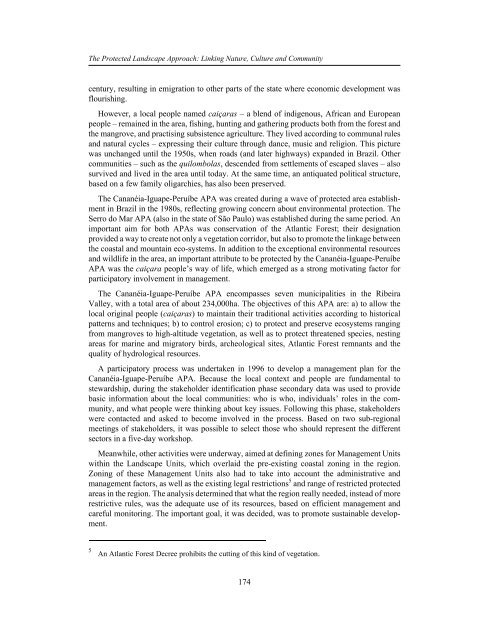The Protected Landscape Approach - Centre for Mediterranean ...
The Protected Landscape Approach - Centre for Mediterranean ...
The Protected Landscape Approach - Centre for Mediterranean ...
Create successful ePaper yourself
Turn your PDF publications into a flip-book with our unique Google optimized e-Paper software.
<strong>The</strong> <strong>Protected</strong> <strong>Landscape</strong> <strong>Approach</strong>: Linking Nature, Culture and Community<br />
century, resulting in emigration to other parts of the state where economic development was<br />
flourishing.<br />
However, a local people named caiçaras – a blend of indigenous, African and European<br />
people – remained in the area, fishing, hunting and gathering products both from the <strong>for</strong>est and<br />
the mangrove, and practising subsistence agriculture. <strong>The</strong>y lived according to communal rules<br />
and natural cycles – expressing their culture through dance, music and religion. This picture<br />
was unchanged until the 1950s, when roads (and later highways) expanded in Brazil. Other<br />
communities – such as the quilombolas, descended from settlements of escaped slaves – also<br />
survived and lived in the area until today. At the same time, an antiquated political structure,<br />
based on a few family oligarchies, has also been preserved.<br />
<strong>The</strong> Cananéia-Iguape-Peruíbe APA was created during a wave of protected area establishment<br />
in Brazil in the 1980s, reflecting growing concern about environmental protection. <strong>The</strong><br />
Serro do Mar APA (also in the state of São Paulo) was established during the same period. An<br />
important aim <strong>for</strong> both APAs was conservation of the Atlantic Forest; their designation<br />
provided a way to create not only a vegetation corridor, but also to promote the linkage between<br />
the coastal and mountain eco-systems. In addition to the exceptional environmental resources<br />
and wildlife in the area, an important attribute to be protected by the Cananéia-Iguape-Peruíbe<br />
APA was the caiçara people’s way of life, which emerged as a strong motivating factor <strong>for</strong><br />
participatory involvement in management.<br />
<strong>The</strong> Cananéia-Iguape-Peruíbe APA encompasses seven municipalities in the Ribeira<br />
Valley, with a total area of about 234,000ha. <strong>The</strong> objectives of this APA are: a) to allow the<br />
local original people (caiçaras) to maintain their traditional activities according to historical<br />
patterns and techniques; b) to control erosion; c) to protect and preserve ecosystems ranging<br />
from mangroves to high-altitude vegetation, as well as to protect threatened species, nesting<br />
areas <strong>for</strong> marine and migratory birds, archeological sites, Atlantic Forest remnants and the<br />
quality of hydrological resources.<br />
A participatory process was undertaken in 1996 to develop a management plan <strong>for</strong> the<br />
Cananéia-Iguape-Peruíbe APA. Because the local context and people are fundamental to<br />
stewardship, during the stakeholder identification phase secondary data was used to provide<br />
basic in<strong>for</strong>mation about the local communities: who is who, individuals’ roles in the community,<br />
and what people were thinking about key issues. Following this phase, stakeholders<br />
were contacted and asked to become involved in the process. Based on two sub-regional<br />
meetings of stakeholders, it was possible to select those who should represent the different<br />
sectors in a five-day workshop.<br />
Meanwhile, other activities were underway, aimed at defining zones <strong>for</strong> Management Units<br />
within the <strong>Landscape</strong> Units, which overlaid the pre-existing coastal zoning in the region.<br />
Zoning of these Management Units also had to take into account the administrative and<br />
management factors, as well as the existing legal restrictions 5 and range of restricted protected<br />
areas in the region. <strong>The</strong> analysis determined that what the region really needed, instead of more<br />
restrictive rules, was the adequate use of its resources, based on efficient management and<br />
careful monitoring. <strong>The</strong> important goal, it was decided, was to promote sustainable development.<br />
5<br />
An Atlantic Forest Decree prohibits the cutting of this kind of vegetation.<br />
174

















